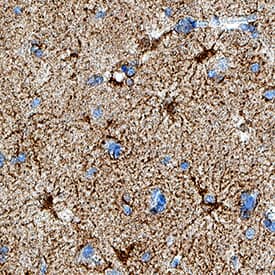Human Leptin R Antibody
R&D Systems, part of Bio-Techne | Catalog # MAB867R

Key Product Details
Species Reactivity
Applications
Label
Antibody Source
Product Specifications
Immunogen
Phe22-Asp839
Accession # P48357
Specificity
Clonality
Host
Isotype
Scientific Data Images for Human Leptin R Antibody
Leptin R in Human Brain (Cortex).
Leptin R was detected in immersion fixed paraffin-embedded sections of human brain (cortex) using Mouse Anti-Human Leptin R Monoclonal Antibody (Catalog # MAB867R) at 0.5 µg/mL for 1 hour at room temperature followed by incubation with the Anti-Mouse IgG VisUCyte™ HRP Polymer Antibody (Catalog # VC001). Before incubation with the primary antibody, tissue was subjected to heat-induced epitope retrieval using Antigen Retrieval Reagent-Basic (Catalog # CTS013). Tissue was stained using DAB (brown) and counterstained with hematoxylin (blue). Specific staining was localized to cell bodies and processes. View our protocol for IHC Staining with VisUCyte HRP Polymer Detection Reagents.Applications for Human Leptin R Antibody
Immunohistochemistry
Sample: Immersion fixed paraffin-embedded sections of human brain (cortex)
Western Blot
Sample: Recombinant Human Leptin R Fc Chimera (Catalog # 389-LR)
Formulation, Preparation, and Storage
Purification
Reconstitution
Formulation
Shipping
Stability & Storage
- 12 months from date of receipt, -20 to -70 °C as supplied.
- 1 month, 2 to 8 °C under sterile conditions after reconstitution.
- 6 months, -20 to -70 °C under sterile conditions after reconstitution.
Background: Leptin R
Leptin receptor (OB-R), also named B219, is a type I cytokine receptor family protein with significant amino acid sequence identity with gp130, G-CSF receptor, and the LIF receptor. Multiple isoforms of human and mouse OB-R, including a long form (OB-RL) with a large cytoplasmic domain capable of signal-transduction, and several receptor isoforms with short cytoplasmic domains (OB-Rs) lacking signal-transducing capabilities, have been identified. The extracellular domains of the short and long forms of OB-R are identical. An OB-R transcript, lacking a transmembrane domain and potentially encoding a soluble form of the receptor, has also been described. OB-RL transcripts were reported to be expressed predominantly in regions of the hypothalamus previously thought to be important in body weight regulation. Expression of OB-Rs transcripts have been found in multiple tissues, including the choroid plexus, lung, kidney, and primitive hematopoietic cell populations. OB-R has been shown to be encoded by the mouse diabetes (db) and rat fatty (fa) genes. Rodents homozygous for the db or fa mutations have been known to exhibit an obesity phenotype. Human OB-R long form encodes a 1165 amino acid (aa) precursor protein with a 22 aa signal peptide, an 819 aa extracellular domain, a 21 aa transmembrane domain and a 303 aa cytoplasmic domain. The extracellular domain of OB-R contain two hemopoietin receptor domains, a fibronectin type III domain and the WSXWS domain. Recombinant soluble OB-R has been shown to bind Leptin with high affinity and is a potent Leptin antagonist.
References
- Tartaglia, L.A. et al. (1995) Cell 83:1263.
- Cioffi, J.A. et al. (1996) Nature Medicine 2:585.
- Tartaglia, L.A. (1997) J. Biol. Chem. 272:6093.
Long Name
Alternate Names
Gene Symbol
UniProt
Additional Leptin R Products
Product Documents for Human Leptin R Antibody
Product Specific Notices for Human Leptin R Antibody
For research use only
